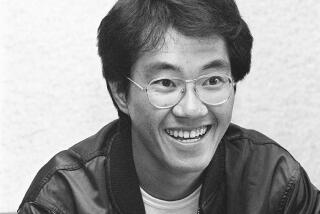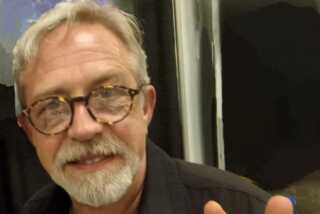Ralph McQuarrie dies at 82; created the look of ‘Star Wars’
When director George Lucas hired illustrator Ralph McQuarrie in 1974 to do a series of paintings visualizing scenes from his script for an intergalactic war movie he was trying to sell, McQuarrie liked the concept for the space fantasy. He just didn’t think it would ever get made.
“My impression was it was too expensive. There wouldn’t be enough of an audience. It’s just too complicated,” he recalled in a 1999 interview with the San Diego Union-Tribune. “But George knew a lot of things that I didn’t know.”
McQuarrie, 82, whose dynamic artwork helped persuade 20th Century Fox to green-light what became the 1977 blockbuster “Star Wars,” died Saturday at his home in Berkeley, said John Scoleri, coauthor of a book on McQuarrie’s art. He had Parkinson’s disease and recently had been in declining health.
“Ralph McQuarrie was the first person I hired to help me envision ‘Star Wars,’” Lucas said in a statement. “His genial contribution, in the form of unequaled production paintings, propelled and inspired all of the cast and crew of the original ‘Star Wars’ trilogy.
“When words could not convey my ideas, I could always point to one of Ralph’s fabulous illustrations and say, ‘Do it like this.’ ”
McQuarrie, a onetime technical artist for Boeing, created the look of Darth Vader, C-3PO, R2-D2, the Stormtroopers and many other “Star Wars” characters.
His production paintings also were used as models for the design of many of the film’s locales such as the desert planet of Tatooine and the Death Star.
In a 2011 interview with the Australian newspaper the Daily Telegraph, McQuarrie said his work on “Star Wars” was “a special opportunity to start from the ground up. Being able to create new characters, vehicles and different worlds…and since when I started it wasn’t even clear that the film would be made, I didn’t have to limit myself.”
He and Lucas would meet every few weeks, McQuarrie recalled, and “he would explain what he was looking for and leave me to my work. Next visit, we would go over my drawings and discuss any changes. We had a very good working relationship.”
As for the iconic look of Darth Vader, McQuarrie said, “George had described Vader as having flowing black robes. In the script, Vader had to jump from one ship to another and, in order to survive the vacuum of space, I felt he needed some sort of breathing mask.
“George said, ‘OK,’ suggested adding a samurai helmet, and Darth Vader was born. Simple as that.”
One of the characters McQuarrie was most fond of was R2-D2.
“He has a lot of personality for a small metal robot,” he said. “The film version isn’t quite as squat as my original concept, but for the most part it reflects my design.”
McQuarrie went on to work as a conceptual designer and a matte painter on “The Empire Strikes Back” (1980) and “Return of the Jedi” (1983).
He also did spaceship design work on Steven Spielberg’s “Close Encounters of the Third Kind” (1977) and “E.T.: The Extra-Terrestrial” (1982) and shared an Academy Award for best visual effects for “Cocoon” (1985).
Among his other credits are the “Battlestar Galactica” TV series and the 1986 film “Star Trek IV: The Voyage Home.”
“One thing that stands out about Ralph’s art work is a sense of scale — he would often juxtapose a tiny figure in a painting to demonstrate the grand scale of the environment the character was in,” said Scoleri, who collaborated with McQuarrie and Stan Stice on the 2007 book “The Art of Ralph McQuarrie.”
“The other thing about Ralph’s work is when he did the paintings for ‘Star Wars,’ he never imagined that those would be seen beyond the people making the movie,” Scoleri said. “And yet 35 years later, those paintings are used as posters and lunchboxes and toys and have a life that he never would have dreamed that those paintings would have had.”
McQuarrie, who was born in Gary, Ind., on June 13, 1929, developed an early interest in art. After serving in the Army during the Korean War — and surviving a bullet that pierced his helmet — he entered what is now the Art Center College of Design in Pasadena.
As a technical artist, McQuarrie worked for Boeing and other companies. He also worked for a company that provided animation for CBS News coverage of the Apollo space program and created artwork for movie posters.
His painting of the original cover art for the first edition of the “Star Wars” movie novelization, which was published before the movie came out, led to his painting dozens of other science fiction paperback covers.
He is survived by his wife of 29 years, Joan; his sister, Joan Wolfe; and two stepsons, Vaughn and Leonard Griffin.
More to Read
The biggest entertainment stories
Get our big stories about Hollywood, film, television, music, arts, culture and more right in your inbox as soon as they publish.
You may occasionally receive promotional content from the Los Angeles Times.






